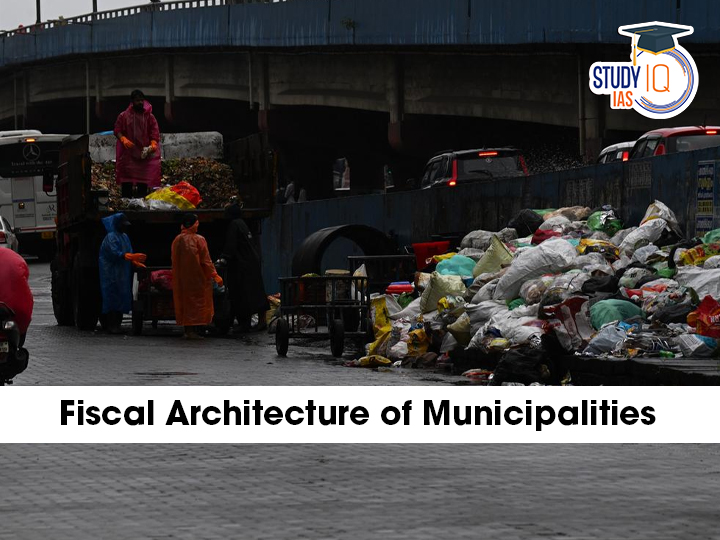Table of Contents
Urban India is the engine of the nation’s economy, contributing nearly two-thirds of India’s Gross Domestic Product (GDP). Yet, paradoxically, Indian municipalities — the governing bodies responsible for managing cities — control less than 1% of the country’s total tax revenue.
Despite being tasked with delivering essential urban services such as waste management, housing, water supply, and climate resilience, most municipalities remain financially handicapped. This imbalance lies at the heart of India’s flawed fiscal architecture — an over-centralised system that deprives cities of adequate fiscal autonomy and predictable revenue sources.
Understanding the Fiscal Architecture of Municipalities
The fiscal architecture refers to how revenue-raising powers, expenditure responsibilities, and fiscal transfers are structured between the Union, State, and Local governments.
In India, this structure has historically been centralised, with the Union and State governments controlling most taxation powers, leaving municipalities dependent on grants, loans, and state-controlled schemes.
Although the 74th Constitutional Amendment (1992) envisioned municipalities as the third tier of government, their fiscal empowerment has largely remained on paper.
How Did Indian Cities Lose Their Tax Revenues?
1. The GST Effect — Loss of Local Revenue Sources
Before the implementation of the Goods and Services Tax (GST) in 2017, cities collected several local taxes such as:
-
Octroi (tax on goods entering the city limits)
-
Entry tax
-
Local surcharges and cesses
These were major sources of revenue for municipal corporations. However, after GST’s introduction, these taxes were subsumed into the unified national tax framework.
As a result, municipalities lost nearly 19% of their own-source revenue.
While the Central and State governments were compensated through a GST compensation mechanism, no such mechanism was extended to municipal bodies. This left cities more dependent than ever on intergovernmental transfers.
2. Dependence on Grants and Loans
Municipalities today depend largely on:
-
State Finance Commission (SFC) and Central Finance Commission (CFC) grants
-
Centrally Sponsored Schemes (CSS) like AMRUT, Smart Cities Mission, and Swachh Bharat Mission
-
Loans and borrowings through state agencies
However, these transfers are unpredictable and conditional. The lack of untied funds restricts cities from making long-term financial plans or addressing local priorities.
This system has created a peculiar inversion of democracy — power is centralised at the top, but responsibility for implementation lies at the bottom.
Why is the Fiscal Architecture Flawed?
1. Over-Centralisation of Taxation Powers
India’s fiscal system is designed in a top-down manner, where most revenue-raising powers are with the Centre and States.
Municipalities can collect only a limited range of taxes (like property tax, water charges, and user fees), which together account for less than 1% of total tax revenue.
This over-centralisation prevents cities from responding effectively to their unique developmental challenges and infrastructure needs.
2. Lack of Predictable and Untied Revenue Streams
Cities cannot rely on a steady flow of funds. Grants from States or the Centre are often delayed, reduced, or reallocated, leaving municipal budgets in constant uncertainty.
This unpredictability leads to project delays, incomplete infrastructure, and poor public service delivery.
3. Weak Fiscal Autonomy
Despite the constitutional promise of decentralisation under the 74th Amendment, municipalities have limited authority over taxation, expenditure, and borrowing.
They remain administratively dependent on State governments, which often retain control over approvals, audits, and recruitment.
In essence, Indian cities are politically accountable for service delivery but financially powerless to fulfil their mandates.
4. Skewed Credit Rating System for Municipal Bonds
The recent policy push for municipal bonds — hailed as the next frontier of local finance — suffers from a flawed credit rating framework.
Credit rating agencies assess a city’s financial health primarily based on:
-
Own-source revenues (property tax, user fees)
-
Balance sheets
However, they often ignore regular grants and transfers from higher levels of government, labelling them as “non-recurring income.”
This undervalues cities’ actual fiscal capacity and discourages investors, making municipal bonds a limited option for most Indian municipalities.
5. Inequitable “User Pays” Model
Global institutions like the World Bank and Asian Development Bank advocate for cities to become financially self-reliant through:
-
Higher property taxes
-
User fees for services like water, sanitation, and waste management
While such reforms are important, they are inadequate and unjust:
-
Property tax contributes only about 20-25% of potential municipal revenue.
-
Excessive reliance on user charges burdens low-income residents, turning basic public services into market commodities rather than collective entitlements.
This model undermines the principle that clean water, sanitation, and public lighting are rights, not luxuries.
Are Municipal Bonds the Solution?
Municipal bonds can be a valuable tool — but only within a strong fiscal ecosystem. For them to succeed, several reforms are essential:
-
Recognise grants and shared taxes as legitimate city income while assessing creditworthiness.
-
Reform the credit rating process to include governance quality — transparency, citizen participation, and audit compliance.
-
Allow cities to use a portion of their GST compensation or State share as collateral to enhance borrowing capacity.
-
Establish regulatory mechanisms to protect investors and ensure responsible municipal borrowing.
Without these reforms, municipal bonds alone cannot fix the structural imbalance in India’s urban finance system.
Learning from Global Examples
Scandinavian Model of Fiscal Federalism
Countries like Denmark, Sweden, and Norway demonstrate the power of decentralised fiscal systems:
-
Municipalities have the right to levy and collect income taxes directly from residents.
-
This ensures a transparent fiscal relationship between citizens and local governments.
-
Local bodies enjoy both autonomy and accountability, resulting in better governance and higher citizen trust.
These nations treat intergovernmental transfers as a shared fiscal ecosystem, not as top-down charity — a model India can learn from.
The Way Forward: Reimagining Fiscal Federalism in India
-
Constitutional Empowerment of Municipal Finances
-
Strengthen the 74th Amendment with clearer provisions for tax devolution to urban local bodies.
-
-
Predictable and Formula-Based Transfers
-
Finance Commissions must ensure regular, untied, and performance-linked transfers to cities.
-
-
Capacity Building and Transparency
-
Improve urban governance, auditing, and citizen participation in budgeting.
-
-
Integrated Urban Fiscal Framework
-
Combine own-source revenue, grants, and market instruments (like bonds) into a cohesive strategy rather than isolated reforms.
-


 World Summit on Disaster Management (WSD...
World Summit on Disaster Management (WSD...
 Domestic Systemically Important Banks (D...
Domestic Systemically Important Banks (D...
 The Missing Link in India’s Critical M...
The Missing Link in India’s Critical M...

























